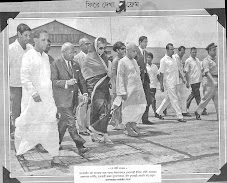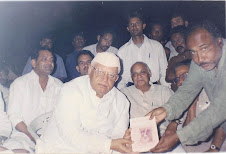From: Press Information Bureau Ministry of I&B <pib.kolkata@gmail.com>
Date: Wed, Jul 14, 2010 at 3:40 PM
Subject: Features for release.......1
Press Information Bureau
Government of India
* * * * * *
ECONOMY FEATURE
IMF's Higher Growth Rate for India is in SYNC
Ashok Handoo*
After a 7.4 percent GDP growth in the last financial year, it is now likely to be 9.5 percent this year. That is what the International Monetary Fund (IMF) has projected for India. This projection is higher than IMF's own April estimates, which put it at 8.8 percent and much more than the estimate made by Reserve Bank of India at 8 per cent and the Government's estimate of 8.5 percent. The logic given by the IMF is that India has a better investment environment and robust corporate profits.
The revised projections seem to be in sync with what has been going on in the Indian economy, currently. Industrial production growth was in double digits consistently for the last 8 months, though in May it came down to 11.5 percent, the lowest. Consumer durables output grew by about 30 percent for the last six months, direct tax collections have jumped by 16 percent, indirect tax collections have shot up by a whopping 43 percent and the exports have increased substantially. Robust excise collections in May indicate a strong pick up in investment. Corporate tax collections grew by 21.7 per cent. Growth rate in the first two quarters has been 8.6 percent so far. In short, the economic environment is booming all around.
In fact, the IMF has revised its estimate of growth for Asia as well, from 6.5 per cent to 7.5 percent. The global growth is put at 4.5 per cent.
The 'World Economic Outlook' of the IMF in which the projections have been made, also says that in 2011 India's growth will be at 8.5 percent because by then the economic measures undertaken by different countries during the global downturn would have run a full cycle and most of the countries would have withdrawn the stimulus packages. Asia's growth rate will thus stabilize at a more "moderate but sustained growth of 6.75 percent," it said. The World growth rate would stabilize at 4.25 percent.
While making these projections the Fund has put some caveats as well. It says the outcome will depend upon "how Europe deals with its fiscal problems, how the advanced countries mange their fiscal consolidation and how the emerging market countries balance their economies". As far as the European Debt Crisis is concerned it has not affected India much so far, though within Europe it has extended from Greece to Portugal and Spain. Despite this, uncertainties do prevail. As the Chief Economist of the IMF, Olivier Blanchard put it "While we remain cautiously optimistic about the pace of recovery, there are dangers ahead".
Indian growth is much more dependent upon the monsoon factor, which affects growth in the agricultural sector. Fortunately, we are receiving good rains this year, though the accompanying floods in some areas can disturb production in the short run. The overall deficit in rainfall has also come down from 16 percent to 10 percent now. Even though agriculture contributes only about 18 percent to the GDP, it has special importance in India because it is widely dispersed and bulk of our population depends on this sector, both directly and indirectly. That is why the industrial sector also looks up to agriculture for its own growth.
Indian growth rate is only next to China, for which the IMF has made a projection of 10.5 percent this year. Strong domestic demand has been one important factor that has seen India through, during the global recession in the last two years, when many countries actually saw a negative growth. Boosting this demand through stimulus packages and fiscal and monetary measures has been the corner stone of our economic policy during this period. While it has stood us in good stead to deal with the situation, it has also boosted inflationary pressures. It is, therefore, time now to return to normal times in a calibrated manner. The RBI has been raising both Repo and Reverse Repo rates, the interest rates at which RBI lends and obtains finances from other banks, to bring down liquidity and thus reduce inflation.
The interest-free infrastructure bonds that are being floated will fetch the Government about $500 billion in the 11th Five Year Plan ending March 2012 and much more thereafter. Since the bonds are for a 10-year period with a lock-in period of five years, the money will remain with the Government for a long period. The excise duties granted earlier are also being withdrawn in a phased manner. The 3-G auction yield will also help reduce fiscal deficit.
The Government is confident that the inflation rate which has touched the double digit mark will come down substantially by the end of this year. It also hopes to bring down fiscal deficit to 5.5 percent of GDP by then. Food inflation, which is a bigger worry, too is expected to come down as soon as the new crops come to the market. At present it is at 12.63 percent after registering a steep fall of 3 percent last month.
Economists believe that food inflation will continue to remain high for some time due to the impact of recent rise in fuel prices, though the government believes that it would not be more than 9 percent.
What India is doing, has been acknowledged as the correct course even at the recently concluded G-29 Summit in Torranto, Canada. World leaders there unanimously agreed that return to normal economies has to be undertaken with caution and in a gradual manner.
Higher growth rate will naturally mean more jobs and higher returns on investment, which is bound to give a further push to investment activities. There is, therefore, a reason to be optimistic. (PIB Features)
Disclaimer : The views expressed by the author in this feature are entirely his own and do not necessarily reflect the views of PIB
*Freelance Writer
rts/vn/ss-114/sf-114/13.07.2010/dk/kol/15:29 hrs.
Press Information Bureau
Government of India
* * * * * *
WOMEN EMPOWERMENT FEATURE
Women Empowerment -Equal Rights, Equal Opportunities
Smt. Anita Patnaik**
The status of women in India has been undergoing a sea-change. Supported by Constitutional guarantees to ensure dignity and equal opportunities, their active participation in all walks of life including education, politics, sport etc., has been growing. Taking note of women's role in the nation-building activities, the Government had declared 2001 as the year of Women's Empowerment by adopting a National Policy to offer "Swashakti" to women. Several laws have also been adopted to empower women socially, economically, legally and politically. Considering the role of rural India, the country's backbone, the Government had taken several measures to strengthen Pachayanti Raj system with the active participation of women. This gave a boost to increase the number of women being elected to the Lok Sabha and State Assemblies, an indication to suggest their political empowerment.
National Policy for the Empowerment of Women – 2001
The principle of gender equality is enshrined in the Indian Constitution in its Preamble, Fundamental Rights, Fundamental Duties and Directive Principles of State Policy. The Constitution not only guarantees equality to women, but also empowers the State to adopt measures of positive discrimination in favour of women. Since the Fifth Five Year Plan (1974-78), India has been making a marked shift in its approach to women's issues from welfare to development while keeping the empowerment of women as the central issue in determining their status in the society. The National Commission for Women was set up by an Act of Parliament in 1990 to safeguard the rights and legal entitlements of women. The 73rd and 74th Amendments to the Constitution in 1993 have provided for reservation of seats in the local bodies of Panchayats and Municipalities for women, laying a strong foundation for their participation in decision-making at the local levels. India has also ratified various international conventions and human rights instruments committing to secure equal rights of women. Key among them is the ratification of the Convention on Elimination of All Forms of Discrimination Against Women (CEDAW) in 1993.
Goals and Objectives
The goals of the National Policy is to bring about the advancement, development and empowerment of women. The objectives include creating an environment through positive economic and social policies for development of women to enable them to realise their full potential, access to health care, quality education, employment, equal remuneration and social security. They also include elimination of discrimination and all forms of violence against women and the girl child and changing societal attitudes.
National Mission for Empowerment of Women
The Government has set up a National Mission for Empowerment of Women early this year and the same has been notified on 8th of March, 2010. The Mission aims at implementing the women-centric programmes in a mission mode to achieve better coordination. The Ministry of Women and Child Development is administering the Support to Training and Employment Programme of Women (STEP) scheme with a view to help assetless and marginalised women become economically self-reliant. The scheme also aims at providing training for skill upgradation, development of entrepreneurial skills, asset creation, mobilisation into small viable groups to enable beneficiaries to take up employment-cum-income generation activities.The Ministry has also launched the "Priyadarshini" scheme to empower vulnerable groups of women in a holistic and sustainable manner by addressing their social, political, legal, health related and economic problems through vigorous capacity-building by organising them into Self-Help Groups (SHGs).
Swarjjayanti Gram Swarozgar Yojana (SGSY)
The Ministry is also implementing the Centrally sponsored scheme. The scheme is desinged to promote self-employment oriented income generating activities for the BPL households in the rural areas. Special safeguards have been provided for vulnerable sections by way of reserving 50 per cent benefits to Scheduled Castes and Scheduled Tribes, 40 per cent for women, 15 per cent for minorities and 3 per cent for disabled persons. Since its inception, about 37 lakh SHGs have been formed and 134 lakh swarozgaris assisted, out of which, approximately 70 lakh (52 per cent) are women. The Rashtriya Mahila Kosh (RMK) scheme extends micro-credit support for income generation to poor women grouped into SHGs in unorganised sector.
India Vision 2020
India Vision 2020 document, while discussing about women in the labour force has, inter alia, mentioned that secure child care support services are necessary for working women. The 11th Five Year Plan document of the Planning Commission incorporated various schemes and programmes for women and child development. It also mentions about the setting up of creches in unorganised sector and restructuring and revamping of the existing Rajiv Gandhi National Creche Scheme for the children of working mothers.
Helplines for Women
As per 2001 census, there are 34.3 million widows and 2.34 million divorced and separated women in the country. The Ministry of Women and Child Development is implementing shelter-based schemes namely "Swadhar" and "Short Stay Homes" under which financial assistance is provided to the implementing agencies for providing support services to women in difficult circumstances. Under the scheme of Integrated Programme for Older persons implemented by the Ministry of Social Justice and Empowerment, financial assistance is provided to NGOs for running and maintenance of Multi Facility Care Centre for older widowed women. The Ministry of Rural Development is implementing Indira Gandhi National Widow Pension Scheme (IGNWPS) and Indira Gandhi National Old Age Pension Scheme (IGNOAPS), under which central assistance is given towards a monthly pension of Rs.200 to widows below the poverty line in the age group of 40 to 64.
Women's Leadership Summit 2010
The Ministry has organised a Women's Leadership Summit in New Delhi on 6th of March this year as part of the celebrations for the International Women's Day. The objective of the Summit, inaugurated by the Prime Minister Dr. Manmohan Singh, was to showcase empowered women, those who had excelled in different fields. The central theme of the Summit was Inclusive Growth and Empowering Women of Rural India. Several women achievers spoke on challenges and opportunities for women in diverse fields such as corporate sector, financial services, agriculture, science, media, panchayati raj, sports, culture, education and law. Government's 100 Days Action Plan
As part of the 100 days Action Plan, the government had proposed several measures to increase the representation of women. It has also proposed Constitutional amendment to provide 50 percent reservation for women in Panchayats and in urban local bodies and to increase the representation of women in government jobs.
India's Tirade Against Anti-Woman Activities
The Government has been adopting several stringent measures to uphold the status of women in India by launching a tirade against injustices done to them. They included protection against domestic violence, stopping crime against child and women, human trafficking, sexual harassment at work place, eliminating beggary among women and street children, child marriages, harassment in dowry related matters, malnutrition among women and children, providing relief and rehabilitation to rape victims. The Centre has allocated Rs.11,000 crore to the Ministry of Women and Child Development for the year 2010-11, an increase of around 50 per cent over last year's Budget Estimates of Rs.7,350 crore. (PIB Features)
**Freelance Writer
Disclaimer : The views expressed by the author in this feature are entirely her own and do not necessarily reflect the views of PIB
rts/vn/ss-112/sf-112/06.07.2010/dk/kol/15:33 hrs.
Press Information Bureau
Government of India
* * * * * *
FEATURE
Building a Solar India
Smt. Prabhavati Akashi**
Launching the Jawaharlal Nehru National Solar Mission on 11th January, 2010, Prime Minister Dr. Manmohan Singh set out a vision for building a Solar India. Now efforts are on to giving wings to his dream. An important step in this direction is the recent announcement of a set of guidelines or ground rules for off-grid or decentralized applications. The National Solar Mission will be implemented in 3 stages leading to an installed capacity of 20,000 MW of grid power, 2,000 MW of off-grid solar applications and 20 million sq. m. solar thermal collector area and solar lighting for 20 million households by the end of the 13th Five Year Plan in 2022.
The immediate aim of the Mission is to focus on setting up an enabling environment for solar technology penetration in the country both at centralized and decentralized levels. Apart from feeding 1,000 MW of solar power (solar thermal and photovoltaic) to the grid, the first phase (up to March 2013) will focus on promoting 200 MW capacity of off-grid solar energy applications to meet/supplement power, heating and cooling energy requirements and promoting 100 MW capacity of tail end and other small grid connected solar power plants.
Off Grid-Solar Applications
Off-grid solar energy applications have tremendous potential in reaching out to people in rural and remote areas by providing lighting and basic energy services to them. These include small solar plants, roof-top solar power applications, solar lights and solar lanterns, solar thermal heating applications such as water heaters for residential, commercial, institutional and industrial applications, etc.
There are many other potential applications. Like off-grid usage, decentralized solar applications too have an immense potential to generate power and reduce diesel consumption particularly during daytime. Roof-top solar power applications for day-time use and abatement of diesel and usage in industrial areas with substantial power shortages could be potential thrust areas. Similarly, solar thermal heating applications, such as water heaters for residential, commercial, institutional and industrial applications are those which are already commercially viable or near grid parity. These and several other solar thermal applications can help urban areas and industries in reducing their dependence on grid besides reducing diesel/gas consumption.
Advantages
· There are a large number of areas in the country, which do not have access to electricity. Off-grid solar energy applications are the easiest to reach out to people in rural and remote areas.
· There are substantial losses as electricity flows from points of generation to distribution. Feeding of power at consumption points would not only help reduce these losses but also help strengthen the grid and its performance and ease the flow of electricity downwards.
· Feeding power to LT/11 KV grid is thus yet another important application, which can help our villages and also industry by providing additional powers to run irrigation pump sets or meet the unmet power requirement in the daytime, as well as avoid use of diesel generators.
· Small solar plants of 1-2 MW capacity can support a large number of irrigation pumps. Many States are keen to set up such plants to augment power supply especially in rural areas. A network of such plants across India will work wonders!
Salient Features
Dr. Farooq Abdullah, Union Minister for New & Renewable Energy launched the guidelines at a function in New Delhi recently. Some of the important features of the guidelines are as follows:
Scope of the scheme
The scheme would be applicable to all parts of India and would, to begin with, be co-terminus with Phase-I of the Jawaharlal Nehru National Solar Mission and will, inter alia, focus on promoting off-grid and decentralized systems, including hybrid systems to meet/supplement power, electricity/power, heating and cooling energy requirements.
Implementation
The Scheme would be implemented through multiple channel partners for rapid up-scaling in an inclusive mode. Channel partners could include Renewable Energy Service providing Companies, Financial Institutions including microfinance institutions acting as Aggregators, Financial Integrators, System Integrators, Programme Administrators.
Funding
Funding under the scheme would be in Project mode, i.e. there must be a project report which would, inter alia, include client details, technical & financial details, O&M and monitoring arrangements. The total project cost shall be funded through a mix of debt and incentives where the promoters' equity contribution would be at least 20% (unless otherwise specified).
MNRE would provide financial support through a combination of 30 % subsidy and/or 5% interest bearing loans .
Release of Funds
The release of funds for the project shall be backended as reimbursement on completion and verification thereof.
Approval
The Committee constituted by MNRE, would approve the project within 45 days of receiving the project.
Project Management Consultant
The Government would engage a reputed agency as a Project Management Consultant (PMC). This agency would handle all the processes such as assistance for formulation, appraisal and screening of proposals preceding the formal approval which would be a sovereign function of MNRE. It would also assist the Ministry in formulating the detailed implementation guidelines/ formats, if any.
Monitoring and Evaluation
The Scheme envisages IT enabled monitoring and verification protocols for which 5% of the total project cost would be available to the various channels partners for compliance.
Technical Requirements
The scheme would require the project proponents to strictly adhere to the national/international standards specified by the Ministry from time to time.
Supporting Innovation
The Ministry could provide 100% CFA for undertaking pilot and demonstration projects for demonstrating new and innovative applications of solar systems.9
Interpretation of the Guidelines
In case of any ambiguity in interpretation of any of the provisions of these guidelines, the decision of the Ministry shall be final.
Review
The scheme would be reviewed by an Internal Review Committee at 6 month/yearly interval and modifications in-therein would be incorporated by the Ministry.
Dr. Abdullah has rightly said, "the guidelines would create the ecosystem that encourages all of the above and that State Governments, entrepreneurs and beneficiaries will take abundant advantage of the schemes and fulfill our dreams for a strong and vibrant Solar India." (PIB Features)
*Director(M & C), Press Information Bureau, New Delhi
rts/vn/ss-112/sf-112/06.07.2010/dk/kol/15:33 hrs.
--
Palash Biswas
Pl Read:
http://nandigramunited-banga.blogspot.com/






















No comments:
Post a Comment